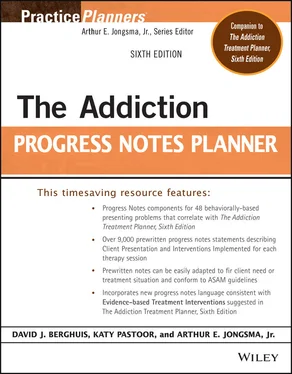The Addiction Progress Notes Planner
Здесь есть возможность читать онлайн «The Addiction Progress Notes Planner» — ознакомительный отрывок электронной книги совершенно бесплатно, а после прочтения отрывка купить полную версию. В некоторых случаях можно слушать аудио, скачать через торрент в формате fb2 и присутствует краткое содержание. Жанр: unrecognised, на английском языке. Описание произведения, (предисловие) а так же отзывы посетителей доступны на портале библиотеки ЛибКат.
- Название:The Addiction Progress Notes Planner
- Автор:
- Жанр:
- Год:неизвестен
- ISBN:нет данных
- Рейтинг книги:5 / 5. Голосов: 1
-
Избранное:Добавить в избранное
- Отзывы:
-
Ваша оценка:
- 100
- 1
- 2
- 3
- 4
- 5
The Addiction Progress Notes Planner: краткое содержание, описание и аннотация
Предлагаем к чтению аннотацию, описание, краткое содержание или предисловие (зависит от того, что написал сам автор книги «The Addiction Progress Notes Planner»). Если вы не нашли необходимую информацию о книге — напишите в комментариях, мы постараемся отыскать её.
The Addiction Progress Notes Planner, Sixth Edition
Addictions Treatment Planner, Sixth Edition
Addiction Treatment Planner, Sixth Edition
The Addiction Progress Notes Planner
The Addiction Progress Notes Planner — читать онлайн ознакомительный отрывок
Ниже представлен текст книги, разбитый по страницам. Система сохранения места последней прочитанной страницы, позволяет с удобством читать онлайн бесплатно книгу «The Addiction Progress Notes Planner», без необходимости каждый раз заново искать на чём Вы остановились. Поставьте закладку, и сможете в любой момент перейти на страницу, на которой закончили чтение.
Интервал:
Закладка:
33 Assign Exercises on Self-Talk (33)The client was assigned homework exercises in which they identify fearful self-talk and create reality-based alternatives.The client was assigned the homework exercise “Journal and Replace Self-Defeating Thoughts” from the Adult Psychotherapy Homework Planner (Jongsma & Bruce).The client was directed to complete the “Daily Record of Dysfunctional Thoughts” from Cognitive Therapy of Depression (Beck, Rush, Shaw, & Emery).The client's replacement of fearful self-talk with reality-based alternatives was critiqued.The client was reinforced for successes at replacing fearful self-talk with reality-based alternatives.The client has not completed assignments for identifying and replacing dysfunctional self-talk and was redirected to do so.
34 Reinforce Positive Self-Talk (34)The client was reinforced for implementing positive, realistic self-talk that enhances self-confidence and increases adaptive action.The client noted several instances from daily life that reflected the implementation of positive self-talk, and these successful experiences were reinforced.
35 Develop Hierarchy of Triggers (35)The client was directed to develop a hierarchy of feared and avoided trauma-related stimuli.The client was helped to list many of the feared and avoided trauma-related stimuli.The client was assisted in developing a hierarchy of feared and avoided trauma-related stimuli.The client's journaling was used to assist in developing a hierarchy of feared and avoided trauma-related stimuli.
36 Direct Imaginal Exposure (36)Imaginal exposure was directed by having the client describe a chosen traumatic experience at an increasing, but client-chosen, level of detail.Cognitive restructuring techniques were integrated and repeated until the associated anxiety regarding childhood trauma was reduced and stabilized.The session was recorded and provided to the client to listen to between sessions.“Share the Painful Memory” from the Adult Psychotherapy Homework Planner (Jongsma & Bruce) was assigned to help direct the client's imaginal exposure.The client's progress was reviewed and reinforced and problems solved.
37 Assign Homework on Exposure (37)The client was assigned homework exercises to perform exposure to feared stimuli and record experience.The client was directed to listen to the taped exposure session to consolidate skills for exposure to feared stimuli.The client was assigned “Gradually Reducing Your Phobic Fear” in the Adult Psychotherapy Homework Planner (Jongsma & Bruce).The client's use of exposure techniques was reviewed and reinforced.The client has struggled in implementation of exposure techniques and was provided with corrective feedback.The client has not attempted to use the exposure techniques and was redirected to do so.
38 Treat Posttraumatic Stress Disorder (PTSD) (38)The client was identified as having a comorbid PTSD diagnosis.The client was treated with prolonged exposure therapy.The client was treated with cognitive processing therapy.The client was treated with eye movement desensitization and reprocessing (EMDR).The client's PTSD symptoms have significantly decreased and positive reinforcement was provided for this.The client's PTSD symptoms have not significantly decreased, and additional treatment in this area was coordinated.
39 Encourage Trust in Own Evaluations (39)The client was encouraged to value, believe, and trust in their evaluations of self, others, and situations.The client was encouraged to examine situations in a nondefensive manner, independent of others' opinions.The client was encouraged to build self-reliance through trusting their own evaluations.The client was assigned “Forming Stable Relationships” in the Addiction Treatment Homework Planner (Lenz, Finley, & Jongsma).The client was reinforced for value, belief, and trust in their own evaluations of self, others, and situations.The client was redirected when tending to devalue, disbelieve, and distrust their own evaluations.
40 Encourage Positive Experiences (40)The client was encouraged to facilitate personal growth and “capacity for sustained joy” by choosing experiences that strengthen self-awareness, personal values, and appreciation of life.The client was encouraged to use spiritual practices and other relative life experiences to help increase positive experiences.
41 Teach Problem-Solving Skills (41)The client was taught problem-solving skills.The client was taught to define the problem specifically, brainstorm options, list pros and cons of each option, choose and implement an option, and evaluate the outcome.The client was assigned the homework exercise “Plan Before Acting” from the Adult Psychotherapy Homework Planner (Jongsma & Bruce).Modeling, role-playing, and behavioral rehearsal were used to apply this skill to several current conflicts.
42 Conduct Transference-Focused Therapy (42)Transference-Focused Therapy was conducted using client-therapist communications.The client was assisted in understanding split representations of self and difficulties with self-control.The client was taught about how to integrate split representations of self and develop more effective means to self-control.
43 Conduct Schema-Focused Therapy (43)Schema-Focused Therapy was conducted with the client.The client was assisted in learning and changing entrenched, self-defeating patterns.The client was focused on the relationship with the therapist and daily life outside of therapy.The client was assisted in exploring early developmental experience that included trauma.
44 Conduct Mentalization Therapy (44)Mentalization Therapy was conducted with the client.The client was assisted in learning to interpret the actions of self and others through meaningful and understanding examination of mental states such as desires, needs, feelings, beliefs, and reasons.
45 Relate Borderline Traits to Addictive Behavior (45)The client was presented with information about how poor impulse control, poor anger management, fear of abandonment, and intense mood swings increase the probability of addictive behavior.The client was assigned “Analyzing Acting-Out Behavior” from the Addiction Treatment Homework Planner (Lenz, Finley, & Jongsma).Active listening was used as the client identified specific incidences from their own life when their borderline traits have led to addictive behavior.The client has reported, as therapy has progressed, decreased incidences of borderline behaviors, with a commensurate decrease in addictive behavior.The client has struggled to identify how poor impulse control, poor anger management, fears of abandonment, and intense mood swings have led to an increase in addictive behavior; the client was provided with specific feedback in this area.
46 Teach About a Higher Power (46)The client was presented with information about how faith in a higher power can aid in recovery from borderline traits and addiction.The client was assisted in processing and clarifying their own ideas and feelings regarding their higher power.The client was encouraged to describe beliefs about the idea of a higher power.The client rejected the concept of a higher power; the client was urged to consider this concept at a later time.
47 Develop an Aftercare Plan (47)The client was assisted in developing an aftercare plan that will support recovery when feeling angry, anxious, abandoned, or depressed.The client was assigned “Personal Recovery Planning” in the Addiction Treatment Homework Planner (Lenz, Finley, & Jongsma).The client has listed several components of an aftercare plan that will support sobriety (e.g., self-help groups and sponsors, family activities, counseling); feedback was provided about the completeness of this plan.The client was reinforced in describing active pursuit of the elements of the aftercare plan.The client has not followed through on an aftercare plan and was redirected to do so.
Читать дальшеИнтервал:
Закладка:
Похожие книги на «The Addiction Progress Notes Planner»
Представляем Вашему вниманию похожие книги на «The Addiction Progress Notes Planner» списком для выбора. Мы отобрали схожую по названию и смыслу литературу в надежде предоставить читателям больше вариантов отыскать новые, интересные, ещё непрочитанные произведения.
Обсуждение, отзывы о книге «The Addiction Progress Notes Planner» и просто собственные мнения читателей. Оставьте ваши комментарии, напишите, что Вы думаете о произведении, его смысле или главных героях. Укажите что конкретно понравилось, а что нет, и почему Вы так считаете.












